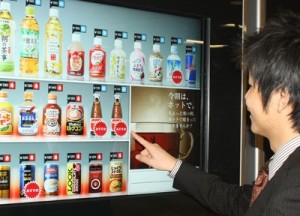New Vending Machine with Recommendations – opportunities and challenges
If you are visiting Japan, it is nearly impossible to walk around streets without encountering vending machines. Despite of recent shortage in electricity supply due to the catastrophic earthquake in the Northeastern Japan, there are over 5 million vending machines across Japan; approximately one for every 25 people. With numerous vending machines available across the country, it is increasingly becoming difficult to make even a slight differentiation from competitors.
Over past few decades, major vending machine operators such as Coca Cola Japan, Suntory and DyDo have been trying to differentiate themselves by offering more convenient payment methods, having wider variety of products, selling both cold and hot beverages and giving discounts on private labels. With the market becoming saturated, a vending machine operator owned by Japan Rail East came up with a new strategy.
A new vending machine, which was first introduced to Shinagawa Station (Tokyo) in August 2010, categorizes each customer into different consumer groups and identifies ideal type of drink to make suggestions.

This machine has a camera and sensors that identify customers’ gender and age group, as well as current temperature and humidity of the location. Using this information, the vending machine recommends certain products out of all selections listed on a 47 inch screen. Customers can choose to buy recommended products or different items they prefer.

I first encountered this vending machine during the last summer in Tokyo. Although I was quite fascinated by the machine, I found several issues with making purchase suggestions.
(1) Inconsistency: When I was wearing a hat and stood in front of the machine, it recommended cola, but after I took it out, the recommendation changed to green tea.
(2) Unclarity: The machine does not tell why it recommends certain types of drink. In other words, customers are suggested make certain choices without knowing why!!
(3) Respect for customers: Because this vending machine makes recommendations based on customers’ appearances, some people might get offended. Engaging in a personalized promotion means some consumers can take offers very personal.
Although I am very skeptical about the accuracy and consistency of this new technology, Japan Rail can potentially benefit from several opportunities.
(1) POP: This vending machine provides operators with significantly better Point-of-purchase marketing opportunities. With recommendations changing based on customer groups and climate conditions, machine operators can easily target different market segments using existing product categories. New machines can also show advertisements when there is no customer standing in front of them.
(2) Better perceived availability: When old vending machines run out of certain types drink, they typically lit “Out of Stock” signs. Newer machines, on the other hand, only lists available products on the screen, which leads to a better perceived availability.
(3) More marketing data: New machines can provide useful marketing data such as gender, age group and preference of customers. Collected data can be analyzed and assessed to provide more accurate product suggestions in the future.
Japan Rail East is planning to install over 500 next-generation machines by the summer of 2012. Success of this machine depends on how well operators target different market segments, and how they manage machine-customer relationships.
If you identify more opportunities and challenges, please let me know by leaving comments.
For more information, visit:
http://blogs.yahoo.co.jp/yumotoshu/2644960.html
http://www.engadget.com/2010/08/11/japan-takes-vending-machines-to-their-logical-47-inch-extreme/
http://www.itmedia.co.jp/news/articles/1008/10/news080.html (Japanese)
